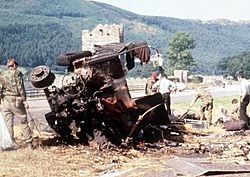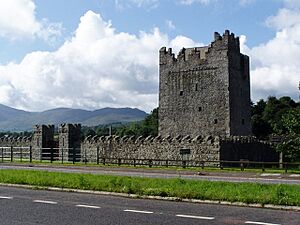Warrenpoint ambush facts for kids
Quick facts for kids Warrenpoint ambush |
|||||||
|---|---|---|---|---|---|---|---|
| Part of The Troubles/Operation Banner | |||||||
 A British Army lorry destroyed in the ambush. The hills of the Cooley Peninsula in County Louth can be seen in the background, behind Narrow Water Castle. |
|||||||
|
|||||||
| Belligerents | |||||||
| Commanders and leaders | |||||||
| Lt Col David Blair † Maj. Peter Fursman † |
Brendan Burns | ||||||
| Units involved | |||||||
| South Armagh Brigade | |||||||
| Strength | |||||||
| 50 soldiers | Unknown | ||||||
| Casualties and losses | |||||||
| 18 killed Over 20 wounded 1 RAF Wessex helicopter damaged |
None | ||||||
| Civilian: 1 killed, 1 wounded by British Army gun fire | |||||||
The Warrenpoint ambush, also known as the Narrow Water ambush, was a surprise attack by the Provisional Irish Republican Army (IRA) on 27 August 1979. The IRA used hidden bombs to attack a British Army convoy near Narrow Water Castle in Northern Ireland. This castle is close to Warrenpoint, in County Down.
The attack killed eighteen British soldiers and injured more than twenty. This made it the deadliest attack on the British Army during a period known as the Troubles. An English civilian was also killed, and an Irish civilian was hurt. Both were hit by British soldiers firing across the border after the first bomb. This event happened on the same day that the IRA also killed Lord Louis Mountbatten. He was a close relative of the British royal family.
What Happened at Warrenpoint?
The ambush took place on the A2 road right outside Warrenpoint. This area is in the south of County Down, Northern Ireland. The road and the castle are next to the Newry River. This river forms part of the border between Northern Ireland and the Republic of Ireland.
The area on the Republic of Ireland's side of the river was perfect for an ambush. It was covered in thick woods, which helped hide the attackers. Also, the river border made it hard for British forces to chase them.
The First Attack
On the afternoon of August 27, 1979, a British Army convoy was driving from Ballykinler Barracks to Newry. The convoy included a Land Rover and two large lorries. These lorries were carrying soldiers from the 2nd Battalion, Parachute Regiment.
At 4:40 PM, as the convoy passed Narrow Water Castle, a large bomb exploded. The bomb weighed about 360 kilograms (800 pounds). It was hidden in hay bales on a parked trailer. IRA members watching from across the border used a remote control to set it off.
The explosion hit the last lorry in the convoy. It flipped the lorry onto its side. Six paratroopers were killed instantly. Their bodies were scattered across the road. Only two soldiers in the lorry survived, but they were badly hurt.
After the blast, some soldiers said they were shot at from the woods across the border. However, the IRA said no shots were fired. Police researchers also thought the soldiers might have heard their own ammunition exploding from the heat. Still, soldiers later swore they were fired upon.
The surviving soldiers called for help. More soldiers were sent by road and by helicopter. A helicopter also landed to pick up the wounded. Lieutenant-Colonel David Blair took charge at the scene.
The Second Attack
The IRA had studied how the British Army reacted after bombings. They correctly guessed that the army would set up a command post at a stone gateway across the road.
At 5:12 PM, thirty-two minutes after the first bomb, another bomb exploded. This bomb also weighed about 360 kilograms (800 pounds). It was hidden in milk containers at the gateway. The explosion destroyed the gateway and sent large pieces of stone flying.
A helicopter carrying wounded soldiers was taking off when the second bomb went off. The helicopter was damaged but did not crash.

The second explosion killed twelve more soldiers. Ten were from the Parachute Regiment. The other two were Lieutenant-Colonel Blair and his signaller. Colonel Blair was the second Lieutenant-Colonel to be killed in the Troubles. Only one of his shoulder badges was found after the blast. This badge was shown to Prime Minister Margaret Thatcher to show the terrible impact of the attack.
A major named Mike Jackson arrived soon after the second explosion. He later described seeing human remains scattered everywhere. He was asked to identify his friend, Major Peter Fursman, whose face was found in the water.
A news photographer, Peter Molloy, arrived after the first bomb. An angry soldier almost shot him for taking pictures instead of helping the wounded. Molloy understood why the soldier was upset.
What Happened After?
The Warrenpoint ambush was the deadliest attack on the British Army during the Troubles. It was also the Parachute Regiment's biggest loss since World War II. General Sir James Glover, a British commander, called it one of the best-planned IRA attacks.
The ambush happened on the same day that Lord Mountbatten was killed by an IRA bomb. He was a very important relative of the British royal family.
Some people who supported the IRA said the attack was revenge for Bloody Sunday in 1972. On that day, the Parachute Regiment shot and killed 13 unarmed civilians in Derry. Messages appeared in areas supporting the IRA, saying "13 gone and not forgotten, we got 18 and Mountbatten."
The day after these attacks, another group called the Ulster Volunteer Force killed a Catholic civilian named John Patrick Hardy. They wrongly thought he was an IRA member.
Soon after the ambush, two IRA members were arrested by the police in the Republic of Ireland. They were later released because there wasn't enough evidence. No one has ever been officially charged with the Warrenpoint ambush.
The attack caused some disagreements between the British Army and the police force in Northern Ireland (RUC). One result was that a new person was appointed to help coordinate intelligence between the army, MI5, and the RUC. The RUC also added 1,000 new members.
Lieutenant-Colonel Blair is remembered on a memorial at Radley College in Oxfordshire.

